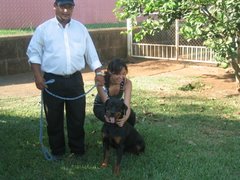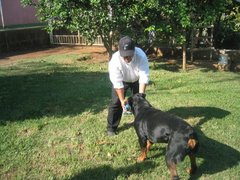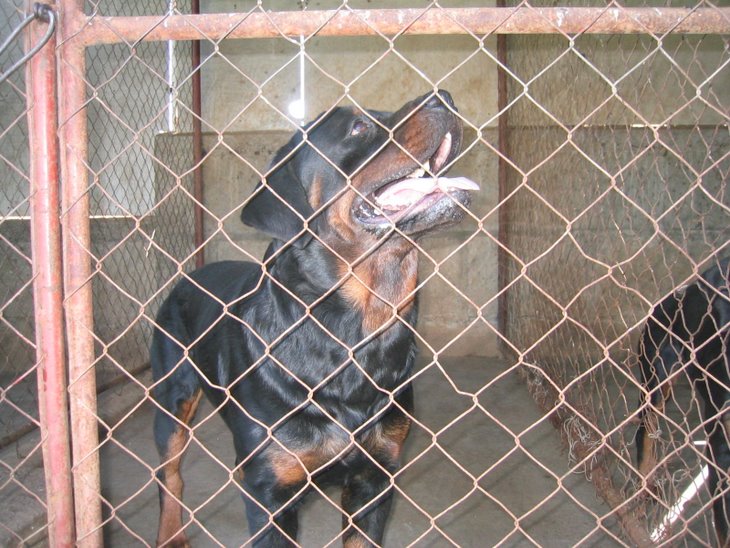
How the Rottweiler Got Its Name
The area of Germany where the Rottweiler's story begins is in the southwestern section, around the productive farm area of Wurttemberg - the district of Rottweil, to be specific, its principal city and district seat bearing the same name.

Around 260 A.D., the Romans were ousted from this area. Left behind were some of their dogs for which work was provided since cattle raising and agriculture remained the prime occupations. It was about 700 A.D. that a Christian church was built where formerly had stood the Roman Baths. As excavation began, the red tiles of former Roman villas came to light, and thus the city was named Rottweil, suggested by the appearance of these red tiles.
Rottweil became a prosperous marketplace and cultural center in time, attracting cattlemen, farmers and other traders from considerable distances to do business there. These men soon noticed the excellence of the "butcher's dogs", as the breed was then known, and started purchasing them. Here again, a capable dog or two was a necessity, not only in bringing in one's stock safely but also making the return trip with their money bags, for which no safer place could possibly be found than fastened to the collars of these dogs!
All of this led to increasing respect for the "butcher's dog", and local owners began selectively breeding them. Since they were considered far superior to others of their type to be found in that area, the name "Rottweiler" was bestowed upon them to distinguish them from the rest. This name has remained until the present day.
Reference: Rottweilers by Anna Katherine Nicholas #1 Best Selling Rottweiler Book

History of the Breed
The origin of the Rottweiler is obscured by the shadowy mists of history. However, most historians of the breed agree that the original blood was of Roman origin. The dog that accompanied the eleventh legion that was to conquer the area we now know as Rottweil in AD74 would not be recognizable as the breed we know today.
To understand the Rottweiler lineage, it is necessary to go even further back in time. Long before Christ, dogs were used in the amphitheatres of Rome for fighting large cats (there were usually three dogs pitted against one lion). These dogs were known as Lollosus dogs. Dogs of this type were also used in the Asiatic wars against rival armies. So it can be understood that planned breeding is not a new idea. There are accounts of dogs of Mastiff type being exported from Britain to Rome through an agent known as the Procurator Pugnacium (provider of dogs). Only the best were good enough to grace the amphitheatres; a second class performance by man or beast was not tolerated and would probably lead to the inevitable 'thumbs down'. It is reasonable to assume therefore, that there would be a residue of canine stock, who for one reason or another would be deemed unsuitable to die for the perverted pleasure of the gloating Roman nobility.
The dog which the eleventh legion would have taken with them would need some herding instinct, be fleet of foot and be powerful enough to guard the herd against wolf or bear. Colour or general type was not important. Driving the cattle that was to feed the troops through the Alps was a Herculan task and it would have been impossible without the dogs.

It is known that dogs of herding and hunting ability were already in north Switzerland and south Germany, an area once known as Helvetia. Best know is the marsh dog of the Swiss Lake people, which was capable of speed and also had a strong powerful jaw. Also domestication of dogs and cattle had been undertaken some twelve hundred years ago in southern Europe by Azilian hunters who used dogs to corner their prey. They were the first known tamers of animals.
The dogs that came with the Romans probably mated with the indigenous population, helping to form many of the breeds we know today. In fact, the indigenous population probably had more influence than most historians believe. The Rottweiler is almost more of a Swiss-type dog than a German one. By this I mean, in Switzerland the Rottweiler has many close cousins, including the Bernese Mountain Dog, Appenzeller and Entlebuch. The Entlebuch is also docked and resembles the Rottweiler to such a degree that it is easy to believe in a common ancestry.
 The Rottweiler originates from a town of the same name, Rottweil, known as Area Flaviae by the Romans. It was an important administration and social centre and had been populated at least two thousand years BC. With the coming of the Romans, the town was developed and transformed. The Orphic mosaic found in Rottweil probably enhanced the house of a wealthy Roman. The Bath House, also discovered in town, tells us how important a site this was. Building continued and the town was upgraded to a fortified villa. The most important buildings would have had red hand-made tiles on the roof and for this reason, the region became known as Rottwil (red villa). This name was changed over a period of time to the name we know today, Rottweil. Between AD250 and 260, the town was conquered by Suebi and Alemanni tribes who slaughtered the Roman habitation. One can only guess what became of the dogs of the town, for they were usually trained to guard their master's property to death. Needless to say some did survive and prosper.
The Rottweiler originates from a town of the same name, Rottweil, known as Area Flaviae by the Romans. It was an important administration and social centre and had been populated at least two thousand years BC. With the coming of the Romans, the town was developed and transformed. The Orphic mosaic found in Rottweil probably enhanced the house of a wealthy Roman. The Bath House, also discovered in town, tells us how important a site this was. Building continued and the town was upgraded to a fortified villa. The most important buildings would have had red hand-made tiles on the roof and for this reason, the region became known as Rottwil (red villa). This name was changed over a period of time to the name we know today, Rottweil. Between AD250 and 260, the town was conquered by Suebi and Alemanni tribes who slaughtered the Roman habitation. One can only guess what became of the dogs of the town, for they were usually trained to guard their master's property to death. Needless to say some did survive and prosper. By the middle ages, the town had become fortified and a royal court of justice, with jurisdiction over a wide area. It is the cattle dealers and butchers of the town who are of most interest to us, for it was they who took the dog of Rottweil and turned him to their use with great effect. Long drives were undertaken from town to town, even country to country. Over a period of time, the dog was moulded to his master's needs, calling on all the virtues of his ancestors: herding ability, speed, guarding ability, strength and power, but most of all, intelligence.
Two types began to emerge: a large ponderous type, used in a draft capacity, for instance, for pulling the butchers' carts full of meat; secondly a smaller, more agile type, used mainly for herding. The latter is nearest to what we know today. Although very large dogs can still be found, they do not excel in the show ring or in the trials arenas.
It was because of this close association with the butchers and cattle drovers, that the Rottweiler was to become known as the metzgerhund, or butcher's dog. One story is told of drovers who, at the end of a long drive, having sold their cattle, would go to the bierkeller to celebrate, but before they did, they would tie the money from the sale around the dog's neck, secure in the knowledge that no matter how drunk they became, their money would be safe until morning! These were good times for the intrepid forefathers of our breed. However, it was not to last.






2 comments:
hey i didnt know many of the things mentioned in this article its pretty interesting. i really love this dogs and i didnt know a thing about them just that they were cute and are good guards.... thanx its been really helpful!!
peace
keep updating the info.....
good luck
kkm
hot stuff here man!! didnt know this things ...
PH
Post a Comment